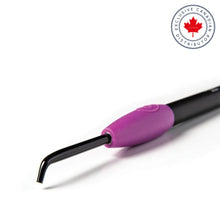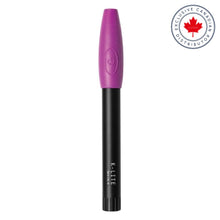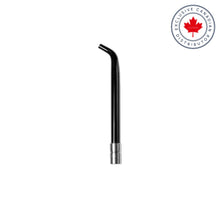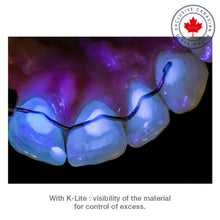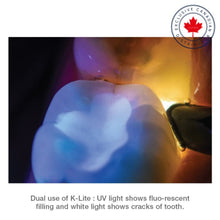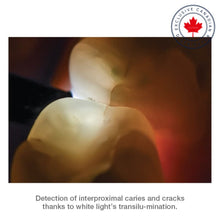K-Lite
Make the invisible, visible! Modern dental composites and adhesives contain fluorophores which gives them a fluorescent property. Under certain wavelengths of illumination ( UV-A 395 to 400nm), these materials can be distinguished from tooth tissue. The K-Lite is a ground breaking, portable, dental device that assists in the identification fo excess or unwanted dental materials and certain bacterial byproducts found in calculus and infected dentin.
Curion is the ONLY authorized distributor of Smile Line products in Canada. This product is backed by the manufacturer's warranty.

Why K-Lite?
Modern dental composites and adhesives contain fluorophores which help in producing better aesthetic results. This gives them a fluorescent property.
Under certain wavelengths of illumination ( UV-A 395 to 400nm), these materials can be distinguished from tooth tissue. Therefore, significantly reducing risk of iatrogenic tooth damage when they need to be removed. The K-Lite is a ground-breaking dental device that allows:
1. the removal of excess or unwanted dental materials such as composites or adhesives. Some of the examples include orthodontic brackets, attachments and retainers, residual cements etc.
2. its use in dental trauma (Splint) and/or in the so-called Fluorescence-assisted Identification Technique (FIT). These two objectives were the motivation for the author to develop and produce the new lamp K-Lite in cooperation with the company Smile Line SA, Switzerland.
3. It can assist in the identification of certain bacterial byproducts found in plaque, calculus and in infected dentine.
- Easy and fast use
- Dual UV and Daylight LEDs
- Portable - No cable
- Easy to handle - Light weight
How does it work?
To achieve our aim, we designed a dual portable flashlight guided by a glass fibre optic, which consists of :
- a White LED (6000 °K) for translumination (i.e. visualisation of opalescence, crack lines and fractures).
- a UV-A LED (violet light) that, when directed onto composites or adhesives with fluorescent components, calculus or plaque, it makes them easier to detect. This way, it helps the clinician to precisely remove them avoiding iatrogenic damage to the healthy underlying tissues.
Product summary
The aim of a minimal invasive dentistry is to preserve as much of the sound tooth tissue as possible. Studies have shown that whilst clinicians are careful in removing excess or unwanted dental materials from tooth tissue, with little guidance this could lead to either excess tooth tissue removal and/or to retention of unwanted dental material








